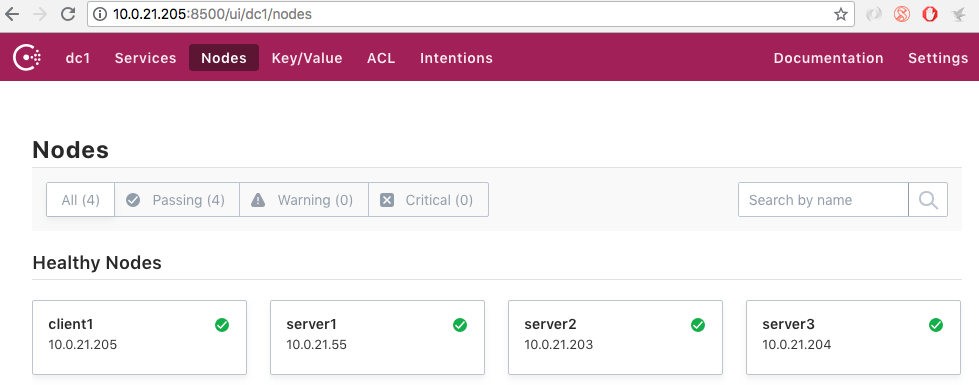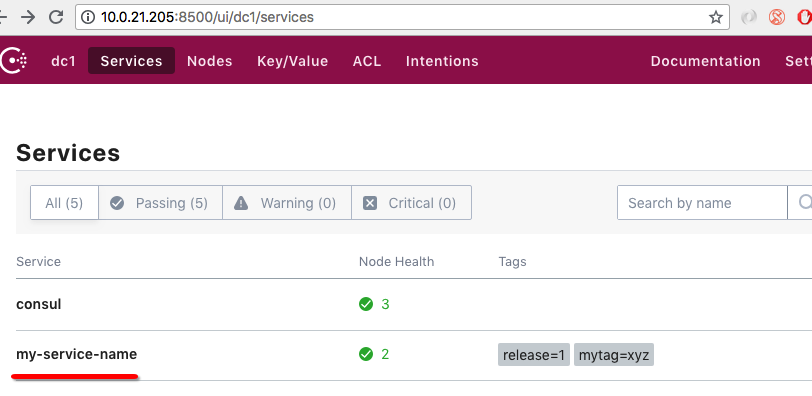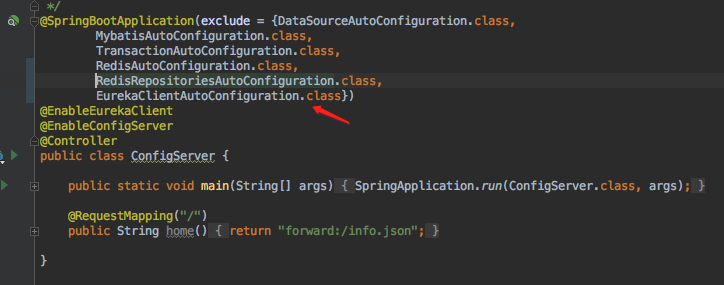Centos7 安裝 consul 1.4.0 替換 spring cloud eureka
eureka官方已經正式宣佈:自2.0起不再維護該專案,並在github 專案wiki上放出了一段嚇唬人的話:

大意就是:從2.x起,官方不會繼續開發了,如果需要使用2.x,風險自負。但其實我覺得問題並不大,eureka目前的功能已經非常穩定,就算不升級,服務註冊/發現這些功能已經夠用。
如果想尋找替代方案的話,建議採用功能更為豐富的consul,除了服務註冊、發現,consul還提供了k-v儲存等其它功能,consul的官網針對其它同類軟體也做了詳細比較,詳見 consul vs other software,有興趣的可以看看,特別是有一句話,翻譯成大白話就是:我不是針對在座的各位,我想說除我之外其它的都是渣渣(足見其相當的自信!)

進入正題,先來看consul的部署安裝:
一、叢集規劃
consul藉助agent來執行,類似elk的logstash agent 或 zabbix監控系統的agent ,每個需要被發現的服務上,通過consul agent client 來收集服務本身的資訊,然後向consul agent server彙報, consul server 可以叢集部署。
規劃一下:
| 序號 | 節點ip | 節點名稱 | 角色 |
| 1 | 10.0.xx.55 | server1 | server |
| 2 | 10.0.xx.203 | server2 | server |
| 3 | 10.0.xx.204 | server3 | server |
| 4 | 10.0.xx.205 | client1 | client & web ui |
這是按正式生產環境來規劃的,如果本機開發,有一個方便的dev模式(後面再講)。 上述表格中,我們打算組建3個server節點的consul server cluster,另外有1個client,模擬客戶端以及充當consul的web admin ui(管理介面)。
二、下載安裝
目前consul的最高版本為1.4.0(本文用1.2.0部署),只需要把相應的release壓縮包 下載到機器上解壓即可。
# wget https://releases.hashicorp.com/consul/1.2.0/consul_1.2.0_linux_amd64.zip
# unzip consul_1.2.0_linux_amd64.zip假設都解壓到~/consul/bin目錄下,解壓後會得到1個名為consul的可執行檔案
為了方便,可以將其複製到/usr/local/bin下(本步驟可選,需要root許可權)
# cp ./consul /usr/local/bin然後檢查下是否安裝成功:
# consul version
Consul v1.2.0
Protocol 2 spoken by default, understands 2 to 3 (agent will automatically use protocol >2 when speaking to compatible agents)如果出現版本輸出,就表示可以了(4個節點上,每臺機器上都重複上述操作,全安裝好)
三、啟動
3.1 啟動server端
基本的命令為:
# consul agent -server -bind=10.0.xx.55 -client=0.0.0.0 -bootstrap-expect=3 -data-dir=/data/application/consul_data/ -node=server1看著一大堆引數,其實不復雜
-server 表示是以服務端身份啟動
-bind 表示繫結到哪個ip(有些伺服器會繫結多塊網絡卡,可以通過bind引數強制指定繫結的ip)
-client 指定客戶端訪問的ip(consul有豐富的api介面,這裡的客戶端指瀏覽器或呼叫方),0.0.0.0表示不限客戶端ip
-bootstrap-expect=3 表示server叢集最低節點數為3,低於這個值將工作不正常(注:類似zookeeper一樣,通常叢集數為奇數,方便選舉,consul採用的是raft演算法)
-data-dir 表示指定資料的存放目錄(該目錄必須存在)
-node 表示節點在web ui中顯示的名稱
啟動成功後,終端視窗不要關閉,可以在瀏覽器裡,訪問下,類似 http://10.0.xx.55:8500/,正常的話,應該會看到一行文字:Consul Agent。
為了防止終端關閉後,consul退出,可以在剛才命令上,加點東西,類似:
nohup xxx > /dev/null 2>&1 &
即:
# nohup consul agent -server -bind=10.0.xx.55 -client=0.0.0.0 -bootstrap-expect=3 -data-dir=/data/application/consul_data/ -node=server1 > /dev/null 2>&1 &將其轉入後臺執行。
另外2臺節點上,也做類似操作:
# nohup consul agent -server -bind=10.0.xx.203 -client=0.0.0.0 -bootstrap-expect=3 -data-dir=/data/application/consul_data/ -node=server2 > /dev/null 2>&1 &注意更改bind引數的ip,以及node引數裡的節點名稱。
# nohup consul agent -server -bind=10.0.xx.204 -client=0.0.0.0 -bootstrap-expect=3 -data-dir=/data/application/consul_data/ -node=server3 > /dev/null 2>&1 &3.2 啟動client端
幾乎完全一樣,只是把-server 去掉,在10.0.xx.205上執行:
# nohup consul agent -client=0.0.0.0 -data-dir=/data/application/consul_data/ -node=client1 -ui > /dev/null 2>&1 &四、組建cluster
現在我們有了3個server node + 1個client node,但是這4個節點都是相互獨立的,可以在任一節點上執行:
# consul members
可以看到,只有自身節點的資訊。
要加自己加入叢集,可以執行以下命令(假設:其它3個節點,都加入10.0.xx.55)
# consul join 10.0.xx.55成功後,會輸出:
Successfully joined cluster by contacting 1 nodes.
其它2個節點(指:10.0.xx.55之外的節點)上類似上述操作,都加入叢集中,完成後,可以再次驗證

可以看到4臺節點的資訊都有了。
tips: 如果反過來,要將1個節點從叢集中撤掉,可以在該節點上執行
# consul leave即可。
五、web ui
10.0.xx.205上,可能有同學注意到了,啟動consul時,我們加了一個 -ui 的引數,這代表將啟動consul自帶的web管理介面,訪問 http://10.0.xx.205:8500/ui

可以看到各節點的資訊。
六、服務註冊/發現/登出

現在services裡,除了consul外,並沒有其它服務註冊進來。可以通過api 手動註冊一個服務:
用postman(或其它rest api工具、curl都行),向 http://10.0.xx.55:8500/v1/agent/service/register ,傳送以下json,http method指定為PUT, Content-Type指定為application/json
{
"ID": "my-service-id",
"Name": "my-service-name",
"Tags": [
"release=1",
"mytag=xyz"
],
"Address": "192.168.1.1",
"Port": 8000,
"Meta": {
"my_version": "4.0"
},
"EnableTagOverride": false,
"Check": {
"DeregisterCriticalServiceAfter": "90m",
"HTTP": "http://yjmyzz.cnblogs.com/",
"Interval": "10s"
}
} 其中的引數名一看就能大概猜出含義,就不詳細解釋了,想深入研究的,建議參看consul api文件。傳送完成後,再看web ui

就能看到新註冊的服務my-service-name,特別要提一下的是tags,eureka中有metadata-map可以提供元資料,consul中對應的特性為tags。
除了web ui,還可以通過rest介面,發現服務的詳細資訊:
http://10.0.21.55:8500/v1/agent/services 這個rest api可以列出所有服務:
{
"my-service-id": {
"Kind": "",
"ID": "my-service-id",
"Service": "my-service-name",
"Tags": [
"release=1",
"mytag=xyz"
],
"Meta": {
"my_version": "4.0"
},
"Port": 8000,
"Address": "192.168.1.1",
"EnableTagOverride": false,
"CreateIndex": 0,
"ModifyIndex": 0,
"ProxyDestination": "",
"Connect": null
}
}服務發現,其實就是通過這個api實現的,有服務註冊就會有反向操作:服務登出。同樣也是通過api完成
# curl -X PUT http://10.0.21.55:8500/v1/agent/service/deregister/my-service-id這樣就把my-service-id這個服務給登出了
七、dev開發者模式
前面這一陣折騰需要好幾臺機器,本機除錯開發時不太方便,為此consul體貼的提供了dev模式,使用方式極為簡單
# consul agent -dev開發模式,自帶了web ui,直接http://localhost:8500/ 即可,非常方便。
八、與spring-cloud的整合
前面這些鋪墊,其實就是為了與spring-cloud的整合,非常簡單:
compile('org.springframework.cloud:spring-cloud-starter-consul-discovery')
新增對org.springframework.cloud:spring-cloud-starter-consul-discovery的依賴
然後application.yml中配置如下節點:
spring:
...
cloud:
consul:
host: 127.0.0.1
port: 8500
discovery:
tags: version=1.0,author=yjmyzz
healthCheckPath: /info.json
healthCheckInterval: 5s
instanceId: ${spring.application.name}:${vcap.application.instance_id:${spring.application.instance_id:${random.value}}}注:
一般在需要部署的微服務機器上,都約定安裝consul agent,所以這裡host通常指定為127.0.0.1 (本機測試consul可用dev模式啟動);
tags 相當於eureka裡的metadata-map,大家根據實際需要設定
healthCheckPath 為健康檢查的url,可以配置成/health或其它能檢測出微服務執行狀態的url
healthCheckInterval 為healthcheck的時間間隔
instanceId這一長串,spring cloud官網文件的推薦,為了保證生成一個唯一的id ,也可以換成
${spring.application.name}:${spring.cloud.client.ipAddress}
(即:以ip結尾),這個instanceId即為consul service列表中的service id

最後提醒一下:如果使用consul來替換eureka,而你的專案中又依賴了eureka的jar包,最好將eureka的自動配置從啟動類裡排除掉,參考下面:

注:如果專案的pom/gradle依賴項裡,已經移除了org.springframework.cloud:spring-cloud-starter-eureka-server 就不用exclude排除EurekaClientAutoConfiguration,另外上圖中@EnableEurekaClient 也可以換成@EnableDiscoveryClient
參考文件:
1、https://www.consul.io/api/index.html
